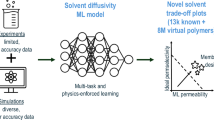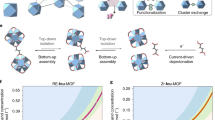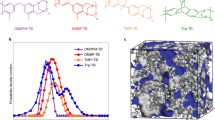Abstract
A polysilsesquioxane-based organic-inorganic hybrid membrane was prepared and applied as a proton-conducting membrane for fuel cells. poly(STES-ran-MTES), a random copolymer of ethyl 4-(2-methyl-3-triethoxysilylpropoxy)benzenesulfonate (STES) and triethoxy(methyl)silane (MTES) was synthesized by hydrolysis and condensation in the presence of hydrochloric acid under a nitrogen stream. The molecular weight was 7500–7600 g mol−1, and the percentage of hydrolyzed ethoxysulfonyl group was 32–50%. A poly(STES-ran-MTES) membrane was prepared by heating for several days, which showed thermal resistivity up to 200 °C and proton conductivity of 2.0 × 10−5 to 1.1 × 10−3 S cm−1 at room temperature. By contrast, a membrane of a block copolymer, poly(SPES-block-PMS), showed proton conductivity of 2.5 × 10−3 S cm−1. The proton conductivity of the poly(3-(4-ethoxysulfonylphenoxy)-2-methylpropyl)silsesquioxane (SPES) membrane increased from 2.7 × 10−3 S cm−1 at 25 °C to 1.0x10−2 S cm−1 at 110 °C. The proton conductivity of the SPES membrane increased from 2.7 × 10−3 S cm−1 at relative humidity (RH)=25–30% to 2.0 × 10−3 S cm−1 at RH=60% and 1.4 × 10−1 S cm−1 at RH=90%. The mixture of SPES and poly(vinyl alcohol), poly(ethylene oxide) or polyoctahedralpolysilsesquioxane showed proton conductivities of 2.7 × 10−3, 1.5 × 10−3 and 2.5 × 10−3 S cm−1, respectively, at 25 °C and RH=25–30%. The open-circuit voltage of the SPES membrane was 0.92 V.
Similar content being viewed by others
Log in or create a free account to read this content
Gain free access to this article, as well as selected content from this journal and more on nature.com
or
References
Steel, B. C. H. & Heintzel, A. Materials for fuel-cell technologies. Nature 414, 345–352 (2001).
Kreuer, K. D. Proton conductivity: materials and applications. Chem. Mater. 8, 610–641 (1996).
Mehta, V. & Cooper, J. S. Review and analysis of PEM fuel cell design and manufacturing. J. Power Sources 114, 32–55 (2003).
Kreuer, K. D., Paddison, S. J., Spohr, E. & Schuster, M. Transport in proton conductors for fuel-cell applications: simulations, elementary reactions, and phenomenology. Chem. Rev. 104, 4637–4678 (2004).
Hickner, M. A., Ghassemi, H., Kim, Y. S., Einsla, B. R. & McGrath, J. E. Alternative polymer systems for proton exchange membranes (PEMs). Chem. Rev. 104, 4587–4612 (2004).
Mauritz, K. A. & Moore, R. B. State of understanding of nafion. Chem. Rev. 104, 4535–4586 (2004).
Deluca, N. W. & Elabd, Y. A. Polymer electrolyte membranes for the direct methanol fuel cell: a review. J. Polym. Sci. Part B: Polym. Phys 16, 2201–2225 (2006).
Lannasch, P. Fuel cell membrane materials by chemical grafting of aromatic main-chain polymers. Fuel Cells 5, 248–260 (2005).
Shao, Y., Yin, G., Wang, Z. & Gao, Y. Proton exchange membrane fuel cell fom low temperature to high temperature: material challenges. J. Power Sources 167, 235–242 (2007).
Abe, Y. & Gunji, T. Oligo and polysiloxanes. Prog. Polym. Sci. 29, 149–282 (2004).
Takamura, N., Gunji, T., Hatano, H. & Abe, Y. Preparation and properties of polysilsesquioxanes: polysilsesquioxanes and flexible thin films by acid-catalyzed controlled hydrolytic polycondensation of methyl- and vinyltrimethoxysilane. J. Polym. Sci. Part A: Polym. Chem 37, 1017–1026 (1999).
Khiterer, M., Loy, D. A., Cornelius, C. J., Fujimoto, C. H., Small, J. H., McIntire, T. M. & Shea, K. J. Hybrid polyelectrolyte materials for fuel cell applications: design, synthesis, and evaluation of proton-conducting bridged polysilsesquioxanes. Chem. Mater. 18, 3665–3673 (2006).
Tezuka, T., Tadanaga, K., Hayashi, A. & Tatsumisago, M. Proton-conductive inorganic-organic hybrid membrane prepared from 3-(2-aminoethylaminopropyl)triethoxysilane and sulfuric acid by the Sol-Gel method. J. Electrochem. Soc. 156, 174–177 (2009).
Aparicio, M., Mosa, J. & Durán, A. Hybrid organic-Inorganic nanostructured membranes for high temperature proton exchange membranes fuel cells (PEMFC). J. Sol-Gel Sci. Tech 40, 309–315 (2006).
Ibrahim, A. C., Devautour-Vinot, S., Naoufalc, D & Mehdi, A. Multi-functional hybrid materials for proton conductivity. N.J. Chem. 36, 1218–1223 (2012).
Gunji, T., Shigematsu, Y., Abe, Y., Inagaki, S. & Hujita, S. Preparation of free-standing films from 3-mercaptopropylpolysilsesquioxane. Koubunshi Ronbunshu 10, 750–707 (2007).
Gunji, T., Shigematsu, Y., Kajiwara, T. & Abe, Y. Preparation of free-standing films with sulfonyl group from 3-mercaptopropyl(trimethoxy)silane/1,2-bis(triethoxysilyl)ethane copolymer. Polym. J. 42, 684–688 (2010).
Fujita, S., Koiwai, A., Kawasumi, M. & Inagaki, S. Enhancement of proton transport by high densification of sulfonic acid groups in highly ordered mesoporous silica. Chem. Mater. 25, 1584–1591 (2013).
Kaneko, Y., Toyodome, H., Mizumo, T., Shikinaka, K. & Iyi, N. Preparation of a sulfo-group-containing rod-like polysilsesquioxane with a hexagonally stacked structure and its proton conductivity. Chem. Eur. J 20, 9394–9399 (2014).
Tezuka, T., Tadanaga, K., Hayashi, A. & Tatsumisago, M. Inorganic-organic hybrid membranes with anhydrous proton conduction prepared from 3-aminopropyltriethoxysilane and sulfuric acid by the Sol-Gel method. J. Am. Chem. Soc. 128, 16470–16471 (2006).
Tezuka, T., Tadanaga, K., Hayashi, A. & Tatsumisago, M. Proton conductive inorganic-organic hybrid membranes prepared from 3-aminopropyltriethoxysilane and phosphoric acid by the Sol-Gel method. Solid State Ionics 179, 1151–1154 (2008).
Gunji, T., Yamamoto, K., Tomobe, A., Abe, N. & Abe, Y. Synthesis and properties of polysilsesquioxanes having ethoxysulfonyl group as a side chain. Int. J. Poly. Sci. Article ID 568301 (2012).
Acknowledgements
This work was supported by a Grant-in-Aid for Scientific Research on Innovative Areas ‘New Polymeric Materials Based on Element-Blocks (no. 2401)’ (24102008A02) from the Ministry of Education, Culture, Sports, Science, and Technology, Japan.
Author information
Authors and Affiliations
Corresponding author
Additional information
Supplementary Information accompanies the paper on Polymer Journal website
Supplementary information
Rights and permissions
About this article
Cite this article
Tsukada, S., Tomobe, A., Abe, Y. et al. Synthesis of poly(3-(4-ethoxysulfonylphenoxy)-2-methylpropyl)silsesquioxane and its application as a proton-conducting membrane. Polym J 47, 287–293 (2015). https://doi.org/10.1038/pj.2014.112
Received:
Revised:
Accepted:
Published:
Issue date:
DOI: https://doi.org/10.1038/pj.2014.112



